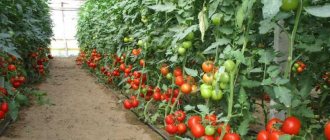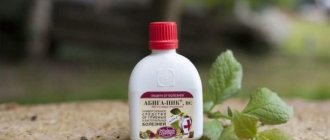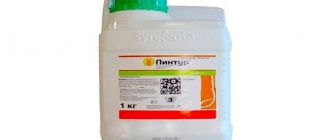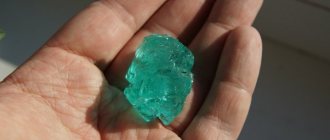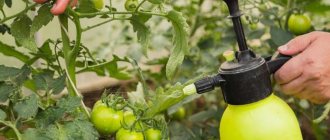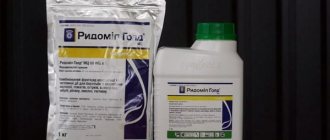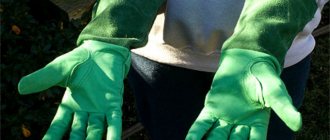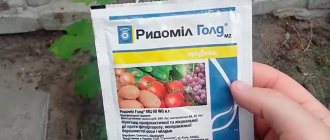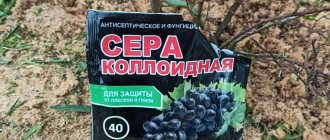Hello, dear readers of my blog. In this article I will tell you about the prevention of grape diseases. Since I have been using Fitosporin for grapes, I have completely forgotten what fungal diseases are.
So, let's get acquainted with Phytotosporin.
This is a unique drug of a new generation. Its peculiarity is that it does not contain chemical elements, but consists of dormant soil bacteria Bacillus subtilis. As a result of reproduction, these bacteria release substances that kill fungal spores and pathogenic bacteria of rot, powdery mildew, and late blight; they are also effective against mildew.
This drug is a systemic drug. What does it mean? It can enter the plant’s vascular system and create unbearable conditions for the spread of putrefactive bacteria and fungi. That's why it's so effective. While chemicals only kill pathogens from the outside, they work from the inside.
Product forms
Fitosporin M is available in several commercial forms:
- liquid - titer of at least 1 billion living cells and spores per 1 ml;
- paste - titer of at least 100 million living cells and spores per 1 g;
- powder - titer of at least 200 million living cells and spores per 1 g.
Packaging for professional use
- Fitosporin M liquid with activator is sold as a set: 5 l canister + activator in a bottle.
- Fitosporin M AS liquid for professional use is sold in 5 liter canisters. AC means amino acids, content in the preparation is 5%. I have very serious doubts about the usefulness of amino acids for plants. Plants themselves synthesize them perfectly and do not need to be supplied from outside, but microorganisms, including Bacillus subtilis, easily utilize them.
- Just liquid for professional use is sold in cans of 5 liters and 10. (10 liters “M, F Storage”). Claims to contain 2% amino acids. Either a by-product of metabolism, or remnants of a nutrient medium.
- Liquid "Fitosporin M, F Extra" is sold in 5 liter canisters. It differs in the content of a number of macro and micro elements in chelate and amino-chelate form.
- Liquid “Fitosporin-M, Zh Fungi-Bactericide” in 10 liter canisters. Claims 2% amino acids.
- Powder in 15 kg bags.
In my opinion, this entire range of liquids with different additives is pure marketing tactics. Which one should I buy? Take the cheapest one.
Packaging for use in the country and for general home use
- “Fitosporin M Reanimator” - liquid in 200 ml bottles from OZHZ Kuznetsov;
- “Fitosporin M” - liquid in 500 ml bottles from OZHZ Kuznetsov;
- "Fitosporin K Olympic" - powder from "BashInkom";
- Paste “Fitosporin M” in packages of 10, 30, 100, 200 grams from OZHZ Kuznetsov;
- liquid in plastic bottles of 110 ml. from BASHIncom.
There are probably other options, but I haven't seen them.
Which one should I buy? If you have a choice, it is better to take it in professional packaging or from it - by acquaintance, for example. If this is not possible, then I don’t know. Probably powder from BashIncom. To fully test and compare is a task for several years of field experience, and it is not a fact that the results will be useful. The quality of the drug may depend on the batch, storage conditions, etc.
As you can see, different commercial forms of the drug have different titers. Therefore, the instructions for use differ depending on the product form you choose. Most often, gardeners take paste - it is found on sale more often than others.
Fitosporin M use, reviews about the drug.
Fitosporin-M is a unique drug that is used to treat tomatoes, potatoes, flowers, and gooseberries against powdery mildew. In general, this is such a multi-functional drug, and every gardener should have it, phytosporin must be constantly used.
The drug Fitosporin-M comes in two different types - powder (gray) and paste (solid form) and many people do not understand how to process these powders and pastes. On the packaging itself there are instructions that indicate the consumption rates.
Phytosporin powder (gray in color) is a type of biological preparation and is harmless to humans; there is also a 200 g paste. The instructions for use inform that the preparation contains more than 100 million living cells and spores. These beneficial microorganisms suppress our pathogenic microflora and fungal bacterial diseases, of which there are many in gardens and vegetable beds.
Composition of phytosporin, how it works
Fitosporin contains live bacteria and spores of Bacillus Subtilis bacteria and, depending on the name, various additions - microelements, amino acids, blablabla. Either it contains it or it doesn’t - who will check?
When spraying or watering the soil, we populate them with a huge amount of Bacillus hay, and not the usual one, but the 26D strain, which is actively produced by antibiotic and fungistatic substances. They suppress the development of other bacteria and fungi, including pathogenic ones, kill them and immediately lyse them. Bacillus subtilis is not dangerous for living plants; it is a saprotroph. In addition, Bacillus subtilis produces many different substances in addition to antibiotics. According to the manufacturer, some of them stimulate plant development. Below in the text of the article there are references to studies that, to one degree or another, confirm this.
Pros and cons of using
The positive aspects of using a biologically active agent are that:
- you can use it without the risk of making the crop inedible not only before the ovary appears on the bushes, but during the ripening period of the berries;
- it is used in the fight against a wide range of grape diseases caused by fungal or bacterial infection;
- temperatures at which the drug works successfully range from –50 °C to +40 °C;
- multifunctionality - acceleration of growth, strengthening of the root system, antiseptic treatment;
- The environmentally friendly substance is not dangerous for animals, bees, or humans;
- combined with other drugs;
- improves the quality of the crop;
- relatively low cost.
See also
Description and characteristics of Alexa grape variety, planting and cultivationRead
The disadvantages of a biologically active product are that the active element decomposes in sunlight, and is inferior in the effectiveness of treating plants to chemical analogues.
How to properly dilute phytosporin paste
For some reason, working with paste raises the most questions, although it contains a rather active stick, it is more difficult to awaken it from powder. So, first, the required amount of paste is diluted in a small amount of water - relatively speaking, 1 part of the paste in 10 parts of clean, non-chlorinated water. Chlorinated or fluoridated water is not suitable: fluoride or chlorine will destroy bacteria (that's what they are for). Subsequently, the resulting solution is stirred in a tenfold larger volume, and then in the required volume of water, depending on the instructions for use on a specific crop.
note
Some farmers exceed the concentration recommended by the registry by 3-4 times and claim that in this case the drug works better.
For example, you need to prepare 10 liters of solution for treating cucumber powdery mildew; you have paste, it is fresh. How to properly dilute phytosporin?
- First, stir 2 grams of paste in 20 ml of water. In general, some people advise taking a ratio of 1:3, but try stirring something in 6 ml of water, you won’t like it.
- When you get 20 ml of a more or less homogeneous suspension, pour it into 200 ml of water. Don’t forget to also rinse the container in which you mixed the first solution. Mix thoroughly again.
- 200 ml must be mixed with 1800 ml of water and mixed again.
- Mix the resulting 2 liters with another 8 liters of water and obtain a solution suitable for processing.
Why is that? This stepwise reduction in concentration allows for a uniform distribution of the active substance throughout the entire volume of the working solution.
In essence, you need to dilute phytosporin in powder or liquid form for processing in approximately the same way: first mix in a small volume, then in a large volume, increasing the dilution by 10 times each iteration. Finally we get the required volume of working solution.
Application
“Fitosporin” is used for many grape diseases, only some of them are indicated on the package with the product:
- root rot;
- scab;
- powdery mildew;
- rust.
This list can be safely supplemented with traditional diseases of grapevine varieties growing in temperate climates. When choosing fungicides, gardeners often face the question of whether it is possible to treat the vine without spoiling the quality of the crop. When working with Fitosporin, nothing threatens the quality of the berries and human health. This product can be used to treat grapes at any stage of the growing season.
Which is better: trichodermin, phytolavin or phytosporin?
It is very difficult to answer such questions unambiguously. It is obvious that in some conditions, on some crops, against some diseases, one will be more effective, and in others, the second. Therefore, we need to look for scientific publications where they are compared. I found something.
In 2022, the Bulletin of the Orenburg Scientific Center of the Ural Branch of the Russian Academy of Sciences published the article “The use of biological products and antibiotics to suppress tracheomycotic wilt of black currant when propagated by woody cuttings.” The authors of the article compared a fairly large number of options, including phytosporin, trichodermin and phytolavin. The article is quite large, there are many tables and diagrams in it. I'll give two here. They show that specifically for protection against tracheomycosis wilt, phytolavines are better than phytosporin and trichodermin.
I have not come across any other publications on this topic. If you have heard about such studies, please share the information in the comments, I will be grateful.
Important: phytosporin and trichodermin cannot be mixed, they are antagonists.
What gives
- Disease prevention . Fitosporin is an excellent preventative against putrefactive bacteria. Since the product does not work superficially, but from the inside, its effect lasts for at least two weeks.
- Increased immunity, active growth. Once in the vessels of plants, Bacillus subtilis bacteria begin to multiply and secrete enzymes that are necessary for the growth of the root system and leaves. This is a real living factory inside a plant.
- Overcoming stress. Frosts, drought, rainy summers with no sun - all this negatively affects grapes. Phytosporin helps plants overcome such stressful situations.
- Saving crops from rot. Many summer residents know that during prolonged rains, the grape harvest can quickly deteriorate and rot. Therefore, I always treat the fruits with a weak solution of Fitosporin. It is completely harmless. This drug is a probiotic used to treat dysbiosis. Since it is harmless, the berries can be eaten immediately after processing (of course, after washing before use).
That's all I wanted to tell you. I constantly use Fitosporin, and with its help I manage to prevent illness, as well as preserve juicy and fresh grapes until the New Year. Subscribe so you don't miss anything important. Share my articles on social media. networks and with friends, so that they, too, can eat grapes grown on their plots for the New Year.
I will say goodbye, until we meet again.
Sincerely, Rostislav Malyavko.
Fitosporin for cucumbers
Antibiotics produced by active strains of Bacillus subtilis can inhibit pathogens of root rot, Fusarium and Verticillium wilt, as well as downy mildew of cucumber. The latter is found almost everywhere and always and noticeably reduces the yield of both farmers and dachas. Even if phytosporin slows down peronospora for just a week, this will already significantly increase the yield.
To protect cucumbers from root rot and Fusarium wilt, the seeds are treated before sowing. They are soaked in the solution for 1-2 hours and then dried. Can be combined with soaking in microelements. The solution consumption is 100...150 ml per 100 grams of seeds.
How to prepare the solution:
- liquid: 3 ml per 1 liter of water;
- paste: 0.4 g per 1 liter of water;
- powder: 1.g per 1 liter of water.
Instructions for use of "Fitosporin M" on cucumbers in open ground
To protect against downy mildew (peronosporosis), cucumber plants are sprayed for the first time before the first symptoms appear, prophylactically. Subsequent sprayings are carried out at intervals of 10-15 days. Working fluid consumption is 10 l per 100 m2.
- powder: 20...30 g per 10 liters of water;
- paste: 2 grams per 10 liters of water;
- liquid: 40...50 ml per 10 liters of water.
Reviews
- Grodno region, Belarus: if you compare cucumber barrels where there are no phytosporin treatments and barrels where they are, the difference is noticeable. Cucumbers treated with phytosporin also have affected leaves, but much smaller. Fitosporin was liquid, in a retail bottle.
- Smolensk region: until autumn, treatments help, but when it gets colder, all the leaves of the cucumbers are eaten by powdery mildew. In cold weather, phytosporin does not help.
Instructions for using phytosporin on cucumbers in a greenhouse
To protect against root and basal rot, fusarium and verticillium (more about them in the article “Diseases of Cucumber”), cucumber wilts are recommended to be watered in the planting hole when planting. The consumption of the working solution per plant is 100...200 ml.
How to prepare the working solution:
- liquid: 40...50 ml per 10 liters of water;
- paste: 5g per 10 liters of water;
- powder: 20 g per 10 liters of water.
To protect cucumbers from powdery mildew and downy mildew (peronosporosis) in the greenhouse (read more about powdery mildew on cucumbers), regular spraying is carried out with the Fitosporin M working solution. It is recommended to spray for the first time a week before the expected manifestation of the disease (if you have no experience and don’t know when to expect, you can spray immediately after planting in the greenhouse, it won’t get any worse). Subsequent treatments are carried out at intervals of 7...10 days. Solution consumption - 10 liters per 50 m2.
Concentration:
- liquid phytosporin: 20...30 ml per 10 liters of water;
- paste: 1 g per 10 liters of water;
- powder: 10...15 g per 10 liters of water.
Reviews
- Rostov region: treatments with phytosporin and fitoverm in greenhouses are carried out almost once a week, cucumbers almost never get sick.
- Stavropol, farmer: phytosporin from a 5 liter canister really works, paste from small bags is worse.
Compatibility with other substances
"Fitosporin" is compatible with chemical compounds, with the exception of those containing alkali or ingredients that can provoke an alkaline reaction. The list of compatible products includes the antibiotic drug “Fitolavin”, fungicides, growth stimulants, insecticides and many other products.
Mixtures with fungicides
List:
- "Vitivax 200";
- "Quadris";
- "Strobe";
- Tilt Premium;
- "Fundazol".
Compounds with insecticides
Liver compatible:
- "Aktara";
- "Decis";
- "Fitoverm".
See also
Description of the Timur grape variety and characteristics of cultivation and careRead
Instructions for using phytosporin on tomatoes
The effectiveness of using phytosporin against late blight on tomatoes is low: if the weather is damp, foggy, the drug can delay the massive development of the disease by 1-2 days, no more. He copes well with other diseases.
Pre-sowing seed treatment
Pre-sowing seed treatment reduces the risk of root and basal rot, the causative agents of which may be in the soil or on the surface of the seeds themselves. The seeds are soaked in the solution for 1...2 hours, and then dried, but you can, in principle, sow them right away - but this is not entirely convenient. Working fluid consumption is 100...150 ml per 100 grams of seeds.
- liquid: 3 ml of the drug per 1 liter of water;
- paste: 0.2 grams per 1 liter of water;
- powder: 1.5 grams per 1 liter of water.
Reviews
- Minsk region, private household plot: I have been treating seeds with phytosporin for several years, I have never seen black leg or rot.
Fitosporin for tomato seedlings
To protect against root and basal rot, before planting in open ground, the roots of the seedlings are immersed in the mother solution for 1-2 hours, or used for watering the plants after planting. When soaking the roots, the consumption is 1 liter per 100 plants, when watering - 100...200 ml per plant. Before planting seedlings in the greenhouse, you can do the same.
How to prepare the solution:
- Liquid: 40...50 ml per 10 liters of water;
- Paste: 5-6 grams per 10 liters of water;
- Powder: 20...30 g per 10 liters of water.
How to use phytosporin on tomatoes in open ground
To protect tomatoes from late blight, plants are sprayed during the growing season. The first spraying is carried out a week before the expected onset of late blight development in warm weather in the evening, subsequent sprayings are carried out at intervals of 10...15 days. Since the drug is absolutely harmless, you can spray it until the last tomatoes are harvested.
- Liquid: 10 ml per 10 liters of water, working fluid consumption - 10 liters of water per 100 m2;
- Paste: 2 g per 10 liters of water, same consumption;
- Powder: 5 g per 10 liters of water.
Reviews
- Grodno region: until the rains and fogs hit, phytosporin holds the defense a little. In August there is no use for him, only Ordan and meet the waiting period.
- Rostov region: phytosporin does not help at all, only chemistry.
How to use phytosporin on tomatoes in a greenhouse?
To protect tomatoes from late blight and alternaria in greenhouses and greenhouses, plants are sprayed with a phytosporin solution: the first time a week before the possible onset of infection, then every 10-15 days.
How to prepare the solution
- liquid: 5 ml per 10 liters of water;
- paste: 1 g per 10 liters of water;
- powder: 2.5 g per 10 liters of water.
To protect tomatoes from blackleg, root and basal rot, the solution is poured into the planting hole when planting seedlings in a permanent place. Working fluid consumption is 100...200 ml per plant.
How to prepare the solution
- liquid: 40...50 ml per 10 liters of water;
- paste: 5...6 g per 10 liters of water;
- powder: 20 g per 10 liters of water.
Reviews
- Krasnodar region: phytosporin is excellent against fusarium blight on tomatoes in a greenhouse, if poured into the soil (drip irrigation) and over the leaves, concentration 20 grams of powder per 10 liters of water;
- Saratov region: a farmer annually uses phytosporin for irrigation when planting tomatoes in a greenhouse in a permanent place; there are no problems with rot and black leg, even if the temperature drops.
Reviews
Valery: I’ve been using Fitosporin for a long time and I don’t know of another such wonderful drug. As soon as I notice that a plant is becoming lethargic, I immediately add Fitosporin solution to it or spray it on the leaves. Always a great result.
Anatoly: I tried all forms of Fitosporin and decided that it was most convenient to use powder. I prefer to treat plants not at the root, but at the leaves, because this way the drug begins to work faster, and the solution flowing from the leaves moistens the soil just as much as needed. By the way, several times I got carried away and overestimated the amount of the drug in the solution, but did not notice any negative consequences of the overdose.
Natalya: first I tried the drug for spring preventative treatment, and now I spill it on the soil in the greenhouse before planting seedlings, and as soon as the seedlings take root, I spray them with Fitosporin on the leaves. Now I can’t imagine how I managed without him.
Katerina: I treat the substrate with Fitosporin-M solution when replanting indoor plants. They began to quickly take root, are growing well, and look great. Even the foliage became qualitatively different. Over the past three years, not a single diseased plant!
- How to use Decis Profi in the garden
Angelina: just as any Christian should have the Bible at hand, so every gardener should have Fitosporin-M in stock. If you use this drug for preventive purposes, then you will not have to treat the plants. An excellent drug.
Official website and manufacturer's recommendations: https://ojz.bashinkom.ru/page/biozashhita-ot-boleznej
Phytosporin for potatoes
Application for pre-planting treatment of tubers against late blight and rhizoctonia
The paste is diluted approximately 1:2 - 50 grams of paste per 100 ml of water. For 10 kg of tubers you need 100 ml. It is important to carefully process the tubers on all sides.
The liquid is diluted 1:20 - 10 ml of liquid per 200 ml of water. Working fluid consumption is the same
The powder is mixed with water in a ratio of 1:40, that is, only 2.5 grams of powder are needed per 100 ml of water.
Application for protecting potato tubers from rot and fomosis before storage
The regulations provide for such treatment only for liquids, but this is nonsense - regardless of the product form, there is only one drug. It is recommended to increase the concentration of the working solution by 1.5 to 2 times compared to what is used for preplant treatment.
Spraying during the growing season to protect potatoes from late blight and Alternaria blight
During the growing season, phytosporin is used on potatoes mainly as a preventive drug: if late blight has already begun to develop, the bacilli will slow it down a little, but will not restrain it. Therefore, it is important to start treatment early: usually the first time is sprayed when the rows are closed, and then every 10...15 days:
- liquid: 40...50 ml per 10 liters of water, working fluid consumption - 10 liters per 100 m2;
- paste: 2 grams per 10 liters of water;
- powder: 20...25 grams per 10 liters of water.
Reviews
- Ryazan region, farmer, about 12 hectares: satisfied with phytosporin, inhibits late blight no worse than chemicals;
- Rostov region, farmer: treatment with phytosporin does not help at all, late blight kills potatoes and tomatoes immediately;
- Rostov region, private farm: paste and powder from small packages did not help.
Efficiency
In 2011, the journal “Achievements of Science and Technology of the Agro-Industrial Complex” published an article “The effectiveness of natural growth regulators in activating the production process and disease resistance of potato plants.” One of the authors L.I. Pusenkova. The authors of the article compared several options:
- without treatment (control);
- spraying “Fitosporin M” 1 l/ha;
- spraying with “Gumi-20” 0.2 l/ha;
- “Fitosporin M” + “Gumi 20”;
- fertilizer "Borogum", 1 l/ha.
The preparations were applied twice along with herbicides at the beginning of budding and at the end of flowering. All results are presented in the pictures. If you believe the article, then treatment with “Fitosporin M” and the drug “Gumi-20” gives an increase in yield and significantly reduces the infection of potato diseases, and the worse the weather conditions, the more noticeable the compensatory effect of the treatments. I don’t know whether to believe the results. I doubt it a little.
In 2013, the Bulletin of Orenburg State University published an article “The influence of biological products on the storage of potato tubers.” The authors compared several options:
- without processing;
- “Fitosporin M”, 0.5...1 l/t tubers;
- "Gumi 20";
- "Borogum."
Tested for 3 years on potatoes of the Romano and Nevsky varieties. You can see the results in the table in the picture:
If you believe the results, “Fitosporin” protects potato tubers very well from late blight.
Security measures
- It is necessary to work with the drug using personal protective equipment: rubber gloves and boots, goggles, a respirator or gauze bandage, a robe, a hat.
- It is prohibited to eat, drink or smoke while processing soil, plants or preparing a solution.
- At the end of the procedure, you need to change clothes, wash your hands and face with soap, and rinse your mouth.
- It is prohibited to prepare the working solution in containers used for drinking water, eating or preparing food.
Fitosporin on cabbage
Application for protection against blackleg, fusarium, mucous bacteriosis
To protect white cabbage from blackleg, bacteriosis and fusarium wilt, three methods are used - soaking the seeds for 1-2 hours followed by drying, immersing the roots in the working solution before planting in open ground and spraying during the growing season.
Soaking seeds - liquid consumption is 100...150 ml per 100 grams of seeds. Preparation of the solution:
- liquid: 3 ml per 1 liter of water;
- paste: 0.4 g per 1 liter of water;
- powder: 1.5 g per 1 liter of water.
Immersion of roots before planting - liquid consumption is about 1 liter per 100 plants. Preparation of the solution:
- liquid: 4 ml per 1 liter of water;
- paste: 0.6g per 1 liter of water;
- powder: 2 g per 1 liter of water.
Spraying cabbage to protect against mucous bacteriosis and fusarium during the growing season. The first one is carried out a week after planting cabbage seedlings in open ground, the subsequent ones - at intervals of 15...20 days. The consumption of working fluid is about 10 liters per 100 m2. Working fluid concentration:
- liquid: 10...15 ml per 10 liters of water;
- paste: 2 g per 10 liters of water;
- powder: 6-8 g per 10 liters of water.
How to use for garden and indoor plants
The rules of preparation and use should not be violated: a low concentration reduces the effectiveness of treatment, a high concentration can cause harm to plants
It is important to think about protecting the body: safety measures are basic: gloves, a respirator or medical mask, plastic goggles, closed clothing
The concentration of the working solution depends on the type of treatment:
- prevention of mycoses and bacterial infections: per 2 liters of water – 1.5 g of the drug;
- for the treatment of diseases in indoor flowers: take 1.5 g of biofungicide per 1 liter.
For seedlings
Seedlings are watered with phytosporin if blackleg disease or other infections appear
It is important to act wisely and not exceed the concentration of the product. Watering is carried out according to the instructions, using a not very strong solution
Application for roots
Garden and vegetable crops and indoor flowers grow better and get sick less often if young plants are watered in a timely manner with a solution based on Fitosporin. Urgent help is needed when identifying the first stages of root rot development.
For soaking seeds, bulbs, cut shoots for cuttings
Application options:
- Take 4 drops of liquid product per 200 ml of lukewarm water. Fill the base for future plants with the working solution and wait for a certain time (for each type - its own, according to the instructions).
- Dilute Fitosporin paste (prepare a concentrate: 1 part of the drug and 2 parts of water). To soak the planting material, take 4 drops of concentrate and 200 ml of settled water.
Against fungal diseases
The list of problems that Fitosporin successfully copes with is quite wide:
- root rot;
- fusarium;
- rust;
- late blight;
- blackleg;
- powdery mildew;
- mold on seeds and bulbs;
- bacterial cancer;
- snow mold;
- cercospora;
- monolial burn and others.
Be sure to water the soil and process the green mass. To treat infected indoor and garden flowers, use the drug in the following proportions: 1.5 g of Fitosporin per 1 liter of water. In severe forms of fungal and bacterial diseases, advanced conditions, it is advisable to dispose of the flower so that dangerous pathogens do not spread to other crops in the garden, vegetable garden or green corner.
Spraying potatoes
Before planting tubers, it is useful to treat the base with Fitosporin: the risk of potato rotting is reduced, the bushes are stronger, and fungus and other diseases develop less frequently. Pre-planting treatment of crops is individually dipping tubers into a working solution or spraying planting material.
The treatment is carried out with a solution of moderate concentration: 4 tsp per 1 liter of water. facilities.
Rooting cuttings
How to proceed:
- prepare a paste-based concentrate;
- pour a glass of water into a jar, add 4 drops of the product;
- wait a couple of hours, place the cut shoot.
Activation of vegetation
Take 1 tbsp per bucket of slightly warmed water. l. concentrated liquid preparation. The prepared solution is enough to water from 2 to 4 square meters. m of soil near berry bushes, bushes and garden trees.
Indoor plants do not need such a large volume of liquid: 200 ml of water and 2–4 drops of Fitosporin are enough.
Treatment of carrots with phytosporin before storage
Carrot roots can be affected by white rot, gray rot and black dry rot. Their pathogens are sensitive to antibiotics produced by Bacillus subtilis: therefore, treating carrots with phytosporin can reduce losses. root crops are processed immediately before planting, the consumption of working fluid is 0.5 l per 50 kg of carrots. Concentration:
- liquid: 50 ml per 0.5 l of water;
- paste: there is no such application in the register, I would take 5 grams per liter;
- powder: not on the register, I would take about 15 grams per liter.
Toxicity
Preparations based on Bacillus subtilis are approved for agriculture and subsidiary farming. Fitosporin is harmless to warm-blooded animals and humans. The drug belongs to the lowest toxicity class IV.
The stick promotes the digestion of food, the breakdown of proteins and carbohydrates. Bacillus subtilis fights pathogenic microflora. But there are also individual cases when the body reacts to Bacillus subtilis. It can cause severe eye diseases and allergies in humans.
Treatment of apple trees with phytosporin to protect against scab, pomegranate moniliosis, and powdery mildew
To prevent apple scab, powdery mildew and moniliosis, spray with a suspension:
- in the pink bud phase;
- at the beginning of flowering;
- at the end of flowering;
- with an ovary size of about 1.5 cm;
- with an ovary size of about 3 cm;
- then once every 15 days.
The consumption of the working solution is from 10 liters per 100 m2. From - because in summer cottages there are different types of apple trees, including huge ones. Concentration:
- liquid: 20 ml per 10 liters of water;
- paste: there is no such application in the register, I would take 2 grams per 10 liters of water;
- powder: not in the register, I would take about 6 grams per 10 liters of water.
The effectiveness against scab is, to put it mildly, not very high. For complete protection against scab, at least 18 treatments with serious fungicides are done, but you are unlikely to want to do this in your garden. Phytosporin is at least harmless.
Processing apples before storing
Apples during storage are affected by a whole bunch of rots - from the usual moniliosis to the rather rare olive mold. Treating apples with phytosporin before storing them will theoretically reduce losses. Working fluid consumption is 0.5 l per 50 kg, the concentration of the suspension is the same as for carrots.
Efficiency
In 2022, the scientific journal “New Technologies” published an article “Comparative assessment of the effectiveness of the influence of biopreparations “Vitaplan” and “Fitosporin M” on changes in microbial contamination of apples during storage.” Authors: Tatyana Viktorovna Pershakova and a group of comrades. They compared three options:
- without processing;
- treatment with the drug “Fitosporin”, concentration 10 CFU/g;
- treatment with Vitaplan, concentration 10 CFU/g.
The contamination was assessed after six months of storage. As a result, “Fitosporin” slightly reduced the contamination of apples, including mold fungi, but was significantly inferior to “Vitaplan”. It turned out to be noticeably more effective.
UNIVERSAL PLANT PROTECTION FROM DISEASES
Biofungicidal and bacterial preparations
Fitosporin-M is a live spore bacterial culture of Bacillus Subtilis 26D, which suppresses the reproduction of many fungal and bacterial plant diseases with its metabolic products. Effectively protects plants from powdery mildew, helminthosporoid root rot, risoctonia, alternariosis, dry and wet rot of tubers, phomosis, mucous bacteriosis, tracheomic withering, false oral dew, black bacterial podium, bacterial cancer, ceremonies, cerebral gates (dashigoen rot, black mold rot, green moldy rot), rot during storage (white rot, gray rot, black dry rot, phomosis, monilial rot), late blight, snow mold, scab, fruit rot, rust, white spot, rust spot, pink mold, American powdery dew, etc.
In addition, Fitosporin-M has powerful anti-stress, growth-accelerating, immunostimulating properties, which is important during climatic, chemical, pesticide and other stresses and for increasing the productivity of agricultural crops, reducing repeated infections, and restoring the soil microbiota.
Fitosporin-M is used for pre-sowing treatment of seeds and planting material, for spraying crops during the growing season, as well as for treating tubers, root crops, vegetables and fruits before storage. The protective effect of the drug is from sowing to harvesting and during crop storage. The drug is absolutely safe for people, animals, bees and the environment.
The advantage of Fitosporin-M is convenient use, long-term storage (up to 2-4 years) at temperatures from 0 to + 25C, freezing is permissible, compatibility in tank mixtures with chemical pesticides.
Fitosporin-M is environmentally friendly, harmless to humans, animals and insects - does not require waiting time.
How to use phytosporin on strawberries
“Fitosporin M” is used on strawberries to protect against root rot, gray rot of strawberries (botrytis), white and brown spots. In all cases, it is more of a preventative drug.
To protect against root and basal rot, the roots of strawberry seedlings are soaked in a solution before planting in open ground (read more about planting strawberries in August). The duration of soaking is about 2 hours, the consumption of working fluid is about 1 liter per 100 plants. Concentration:
- liquid: 40 ml per 10 liters of water;
- pasta: for some reason it’s not in the register, but if you think about it, it would be 5...6 g per 10 liters of water;
- powder: not on the register either, but 20 grams per 10 liters of water.
To protect against gray rot of strawberries, ramularia and brown spot, spraying of plants is used during the growing season: during the extension of peduncles, at the beginning of flowering and at the beginning of ripening. Working fluid consumption is 10 l per 100 m2. For some reason, only liquid phytosporin is allowed in the register for such use in a concentration of 15 ml per 10 liters of water. However, I think that if there is no liquid, then you can dilute a paste (I think 10 grams per 10 liters of water) or powder (30 grams per 10 liters of water).
Reviews
- Moscow region: I regularly use phytosporin on strawberries, the problem of gray rot is completely solved, but there are still white spots, but not many.
- Brest region: if you use only phytosporin, then all the strawberries will be stained. If you use Bordeaux mixture in the early spring, and Bordeaux mixture in the fall, and phytosporin in the summer, the strawberry leaves will be clean.
Efficiency
In 2015, the journal Arctic Environmental Research (I don’t know what it is) published an article by Irina Tabakova and Olga Chukhina “Comparative assessment of the effect of fungicides of chemical and biological nature on the yield and quality of Fragaria ananassa berries,” that is, what we call strawberries The authors compared several options:
- without treatment (control);
- Sumilex - 1kg/ha;
- Planriz, 4 l/ha, 1 treatment;
- Planriz, 4 l/ha, 2 treatments;
- Fitosporin M, 2 l/ha, 1 treatment;
- Fitosporin M 2l/ha, 2 treatments.
Yield data for 2 years is in the table:
Data on the number of berries affected by gray rot in the diagram:
Data on sugar and vitamin C content:
It’s funny, but the control, that is, the plantation without treatment, showed almost better yield after 2 years, second only to the option with 2 treatments with Fitosporin, but only slightly. The difference in the number of berries affected by gray rot is very noticeable, as well as in the sugar content.
For strawberries and other berries
For strawberries and berries, the drug is extremely important because it increases immunity and stimulates growth. Treatment is carried out in the spring, when planting material is being prepared. You will need to dilute ½ teaspoon of powder with ½ glass of water. The seeds are placed in this solution for 2 hours. If seedlings were purchased, it is recommended to treat them themselves before planting them in the garden.
The roots of the seedlings are sent into a solution made from 10 grams of Fitosporin and 10 liters of water. The same product will help for preventive or therapeutic spraying.
For watering you will need a solution made from 25 milliliters of the drug and 7 liters of water. After fruiting, use a product made from 5 grams of powder and 10 liters of water (let it brew for an hour).
Phytosporin on grapes
The Register does not describe the use of phytosporin on grapes at all. I searched for information on the forums of farmers and winegrowers, and talked with local grape lovers. The conclusions and reviews are as follows:
- Most don't use it at all.
- Some used it to protect against mildew, but abandoned it due to low effectiveness.
- One person from the Rostov region and one from Novocherkassk use phytosporin throughout the season, spraying twice a month and after each heavy rain. It takes about a bucket of water per 100 m. They don’t remember the concentration. Phytosporin protects grapes until about the beginning of the August rains. when the rains begin, they switch to treatment with Bordeaux mixture, which is how they save themselves.
- One farmer from Crimea alternates phytosporin and trichodermin and is doing well.
- One farmer from Belarus used Fitosporin M in paste all season to protect grapes from oidium, including highly susceptible varieties. Concentration - 10 grams of powder per 10 liters of water, treatment once every 10 days, Marolex sprayer with a not very good sprayer. There was oidium, but in minimal quantities.
I don't have any experience of my own.
Composition and properties
The effect of the substance is achieved through the distribution of beneficial bacteria throughout the structure of the plant and the fight against diseases. Can be used for complex pathologies without reducing the effect on the problem.
The drug contains Bacillus subtilis, which when released into plants releases a pathogenic environment in which harmful spores that cause diseases cannot survive.
Important. To use the product on grapes, it is recommended to use a paste. The drug can be used in the problem area without the need to spray the bush.
Phytosporin to protect orchids
Some home orchids can suffer from root rot, as well as leaf spots of fungal and bacterial origin. They experience fusarium, anthracnose, cercospora, etc. At the same time, using powerful healing fungicides at home is dangerous, so treatment with phytosporin is one of the best options, at least for maintaining your health.
To protect against root rot, spill the soil in the pot. The consumption of working fluid depends on the volume of the pot. Concentration:
- liquid: 6 ml per 10 liters of water;
- paste: 3 grams per 10 liters of water;
- powder: 3 grams per 10 liters of water.
To prevent spotting, and also partly for their treatment, the plant is sprayed whole with an interval of 7...10 days. The concentration of the suspension is the same.
How to use phytosporin to protect northern orchids
Slippers, loveworts, palmate roots, orchids and other orchids grown in open ground are affected by a whole host of fungi, and these diseases are only vaguely described in the literature. However, seven troubles - one answer: preventive treatments at intervals of 10...15 days will probably contain spotting and certainly will not make it worse. The concentration is the same as for clematis.
Precautionary measures
Care must be taken when preparing the solution and when using it. Be sure to wear work clothes, gloves, and a respirator. If the product suddenly gets on the skin or mucous membranes, you must rinse them thoroughly. If swallowed, rinse the stomach with water.
Gardener applying insecticidal fertilizer for fruit apples and protects against fungus, aphids and pests using sprayer
Phytosporin for clematis
The main disease of clematis is, of course, wilt. To protect against wilt, clematis is regularly watered with a phytosporin suspension at a rate of 1 liter per plant. I also water at intervals of about 2 weeks. I can’t judge whether it’s effective. This year I lost 2 “President” escapes literally within 10 days of each other. The rest of the collection seems to be fine.
Suspension concentration:
- liquid: 6 ml per 10 liters of water;
- paste: 3 grams per 10 liters of water;
- powder: 3 grams per 10 liters of water.
In addition to vila, clematis is often affected by various spots. They don't do much harm, but they do spoil the appearance. To prevent spotting, you can use spraying with a suspension: the first - at the beginning of shoot regrowth, subsequent ones at intervals of 10...15 days. Concentration:
- liquid: 6 ml per 10 liters of water;
- paste: 3 grams per 10 liters of water;
- powder: 3 grams per 10 liters of water.
Analogues of the product
To treat the soil against fungal diseases before planting, you can select chemical products.
But if you need a biologically pure substance that does not leave harmful traces in the soil, then only Fitosporin is needed. In cases where the drug is not found, there is only one analogue - Trichodermin.
Phytosporin for roses
Preventive spraying of roses with phytosporin is carried out to protect against powdery mildew, spotting and rust. It is effective preventatively, but practically not effective for treating already affected plants. In my opinion, it doesn’t really help with rust at all. Spraying is carried out starting in May with an interval of 10...15 days. Working fluid consumption is approximately 100 ml per 1 m2.
How to prepare a suspension for roses:
- liquid phytosporin: 6 ml per 10 liters of water;
- paste: 3g per 10 liters of water;
- powder: 3 g per 10 liters of water.
Reviews
- Moscow: phytosporin in paste is suitable for preventing powdery mildew on roses, but if powdery mildew has already arrived, it does not help, serious fungicides are needed;
- Novosibirsk: all new roses in pots are soaked through with phytosporin, they are also sprayed with phytosporin and phytoverm from the bottom up, and only after 7-10 days are they planted in the rose garden. Since this practice was introduced, diseases have never arrived with new roses.
If you have your own experience in using phytosporin in the garden, vegetable garden or industrial plantings, please share it in the comments to the article. Any information will be useful to other readers.
Author of the article
Description and principle of action of the drug
The drug Fitosporin differs from all known drugs of the new generation. Based on the reviews left, the substance is used not only as a preventive antibacterial agent. Fitosporin is suitable for therapeutic measures if:
- resoctoniosis;
- bacteriosis;
- black leg.
Seed material, rhizomes, and fruit and berry crops can be treated with the working solution. All this is possible because of the ingredients. But the composition changes, since Fitosporin has different modifications (use for different crops).
If there are different cultures, it is recommended to use a universal preparation. The main active ingredient in all forms and types remains unchanged.
If you look at the instructions for natural Fitosporin, it will become clear that it contains exclusively live spores + cells, bacteria of the 26D strain (another name for Bacillus subtilis). This formula allows plants to become more frost-resistant and heat-resistant. Additional components include:
- chalk for viscosity;
- potassium and phosphorus;
- nitrogen and brown coal.
If there are other additives, this is indicated on the packaging. The drug works simply. In purchased form, spores and bacteria are in the stage of suspended animation. When combined with water, they wake up and begin to actively reproduce. The result is:
- neutralization of dangerous microflora;
- disease resistance;
- boosting the immune system;
- stimulation of growth and development of culture.
Thanks to this mechanism of action, Fitosporin acquired the qualities of an immunomodulator and fungicide.
Interesting fact! Gumi, or a mixture of useful substances that was included in Fitosporin, was created by simple farmers to improve the quality of fruits. Experts took this combination as a basis. Then they improved it and added it to the drug.
Liquid dilution proportions
To use the product correctly, you should initially purchase the release form that is needed for a specific case. The liquid is usually used for spraying crops and treating indoor plants and garden flowers. Can also be used in greenhouses. In rare cases, the instructions for Fitosporin in the form of a liquid solution are recommended for spraying planting material to improve its storage.
So, for preventive treatment of indoor plants, you need to dissolve 1 tablespoon of concentrate in a bucket of water. If there are a small number of house plants, the number should be reduced while maintaining the proportions. To combat emerging ailments, add 2 drops of the product to a glass of water.
To soak seed and planting material before placing it in a permanent place of growth, it is necessary to soak the roots or seeds for 4 hours in a solution made from a liter of water and four tablespoons of liquid.
Instead, tomato seedlings can be watered with a mixture of a bucket of water and 4 tablespoons of the drug a few days after planting. A glass of solution should be poured under each bush.
To feed cabbage, dissolve two drops of Fitosporin in a liter of water. Plants are sprayed during the growing season at intervals of two weeks for prevention. In cases where it is necessary to treat garden crops, a more concentrated composition is prepared - 15 drops per liter of water. It is recommended to water sick plants at the root.
Storage requirements
According to the manufacturer, Fitosporin is stored in any form (not diluted), that is, in powder, liquid or paste, for 4 years. But even after this, it can still be used for its intended purpose, but in a larger dose, since the number of bacteria in it will decrease.
Temperature conditions – from -20 to +30 °C for powder and paste, -5…+25 °C for liquid. The drug should be kept away from food, the paste concentrate should be kept in a dark and preferably cool place, in a closed container. If it was stored in the refrigerator and was frozen, then after thawing it will be suitable for use. It may separate, so you need to stir it. Diluted Fitosporin from powder cannot be stored for more than 2 days.
Features of currant processing
Chemicals affect different crops differently. Treatment of fruit and berry bushes differs from treatment of other types of plants. A separate approach should be taken when treating currants, both black and red.
Tools and security measures
To carry out the treatments you will need a garden sprayer. This is a unit consisting of a solution container, a pump and a sprayer. Garden sprayers are divided into 3 main types - manual, battery and gasoline. The gardener chooses a device based on personal preferences, price and other factors. If the concentrate and the prepared solution come into contact with mucous membranes, they may cause irritation.
When processing, we must not forget about safety measures. "Fitosporin-M" belongs to drugs of the 4th class of toxicity for the human body.
When preparing for spraying, consider 2 basic rules:
- You can only dilute the solution while wearing gloves, without touching the powder with your bare hands.
- You should spray the bushes in a protective suit.
For protection, farmers use:
- gloves;
- glasses;
- respirator;
- overalls and work clothes.
Important! If the solution or powder gets into your mucous membranes (for example, your eyes, nose or mouth), immediately rinse the affected area with water. If your health condition worsens after washing, call a doctor immediately.
Proportions for use
"Fitosporin-M" for currant treatments is sold in powder form. The proportions for preparing the working solution are 5 g of concentrate per 10 liters of water. The specified amount of the drug is enough to spray 100 m² of garden.
Terms of application: frequency and intensity of treatments
Spraying is carried out 2–3 times with an interval of 14–21 days. The number of treatments depends on the level of damage. If the infection has just begun to spread, two sessions are enough. In advanced cases, farmers resort to triple spraying.
The time of the procedure is chosen based on the current weather. "Fitosporin-M" is considered a persistent fungicide, but the effectiveness of the product depends on environmental conditions. The best result is observed with:
- light clouds;
- lack of wind;
- air temperature within +15…+35°С.
Important! It is not advisable to carry out the procedure immediately after rain. On wet leaves, the concentration of the drug decreases and, consequently, the result worsens.
Consumption rates for different crops
Apple and pear trees that have been exposed to ascochyta blight, powdery mildew and anthracnose should be treated 4 times.
To prepare the solution you will need 80 grams of sulfur and 10 liters of water. If the currants are attacked by mites, then you need to prepare the following solution: 10 grams of sulfur per 10 liters of water. To combat powdery mildew, prepare another solution: 30 grams of the substance per 10 liters of water. Processing must be carried out no more than twice.
Garden flowers and tomatoes must be processed no more than 4 times. The solution preparation scheme depends on the air temperature. If the temperature outside is from 30 °C to 35 °C, then 10 liters of water will require 40 grams of sulfur. If temperatures are from 20 °C to 27 °C, then you will need 100 grams of product per 10 liters of water. Spraying is carried out before flowering and after flowering.
Treatment of cucumbers against powdery mildew should be done 4 times. But the concentration of sulfur in the solution should be small: 20 grams per 10 liters of water. The last treatment is carried out one day before harvest.
In addition, colloidal sulfur can be used to process blueberries, grapes and strawberries. Everyone knows that blueberries love acidic soil, so to acidify it, gardeners use sulfur granules 6 months before planting blueberries. Sulfur powder is used twice a year. They use it to cultivate the soil between the rows and around the bush.
Cumulus helps fight spider mites and powdery mildew on strawberries. Spraying is carried out twice: before flowering and after harvesting. For 10 liters of water you will need 100 grams of the substance.
Colloidal sulfur is also useful for grapes. It fights oidium (powdery mildew). This disease is dangerous because it affects all green parts of the grapes. They become covered with a gray coating, and at the same time the smell of rotten fish emanates from them. With this disease, the inflorescences dry out and the berries begin to crack.
To get rid of this disease, you need to mix sulfur with talc, ash and lime. The resulting mixture should be used to pollinate the bushes. Pollination is carried out three times. The first is when the third leaf forms. The second is during flowering. Third, during the period of berry formation. This procedure should be carried out early in the morning or late in the evening. Treatment should not be done in rainy, cloudy, hot or windy weather.
What pests and diseases should the product be used against?
Fitosporin marked “M” is considered a universal, safe drug. The fungicide has found use in gardens and orchards in the battle against fungal infections of soil and plants.
Its main task is to prevent fungal spores from infecting plants. The environmentally friendly product retains all its properties even at -50 and +40 degrees. Under unfavorable conditions, living bacteria freeze, and when conditions become normal, they come to life again.
What else is Fitosporin good for? The fungicide can be used at all stages of crop growth - from seeds to fruiting. The drug comes with instructions, the recommendations of which should not be deviated from.
The fungicide is based on a spore culture, which prevents various types of pathogens from multiplying.
Be sure that a dozen fungal problems will not affect your plantings if you use Fitosporin.
Fitosporin is also good because it can be used as a growth activator. The seedling treated with it begins to grow better.
